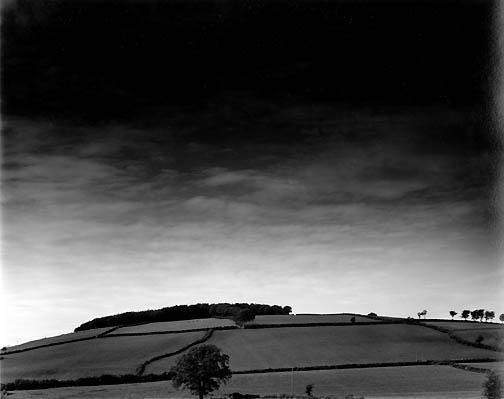
Grove Dordogne, France
Shot in the Dordogne region of France, the picture on the right is a very early work of mine. Two important things come to mind with this picture. First, for years, before I had even taken it, I had dreams about it. In photographic terms, I guess I sort of pre-visualized it. I can remember during the years I shot landscape, consciously looking for this location. Therefore, I assume that this is probably the most introspective picture I’d ever taken, both consciously and subconsciously. You can imagine the joy and sense of fulfillment I felt upon seeing this grove. But unlike many other landscapes where I walk to the spot where I think everything feels right and take the picture, this picture in the place I was familiar with, alluded me.
Upon entering the grove, I immediately knew this picture was there; the trick was where to find it. While it looks very contrived, very precise, and very easy, it was actually very difficult to find. It was there; it just took a long time to isolate the perspective. Like many of my pictures, I only knew I had found it when it felt right. It was not so much an intellectual experience of finding proportion, or scale; rather, it was an emotional or intuitive response that made me say, “Oh my god, this is it. This feels right to me.” I had finally found what I was looking for. The only question remains to this day: what is it I found? Is it a way forward? A way out? Or perhaps a way in?
The second thing is the fact that this is a landscape. It has actually been many years since I have shot a landscape without a figure in it. As I’ve mentioned in earlier posts, there was a time in my life that I shot only portraits and landscapes, but I would not combine the two. This photograph is part of that period. Over the number of years of trying to shoot landscapes, I have only shot 20-30. They are the most difficult thing I shoot.
You have to be in the right place at the right time. One can’t manipulate the landscape. When shooting a figure, if the person is in the wrong place, I can move him or her a few feet. If the sun is in the wrong place, I can turn the figure around, etc. In other words, I can move the figure to fit into the landscape. However, the landscape, which is large, is impossible to move. If I came to this landscape at 8 AM and it was cloudy, it may not work. At 6 PM the light may not be right. Landscapes only work at a particular place and at a particular time.
Many landscape photographers today manipulate the landscape—they use long exposures; they use filters; they do kinds of manipulations that mold the landscape to be what they want it to be. They are able to take the landscape and make it their own. However, I had to operate with the landscape as an integration between me and it. They were the most difficult pictures I ever shot. The following picture is a good example of this.

I lived in Wales, and had driven by this spot multiple times, and I never had any interest in taking this picture. All of a sudden, one evening, for fifteen minutes, the sky was dark and foreboding. This picture presented itself. In the next half hour, it didn’t exist.

